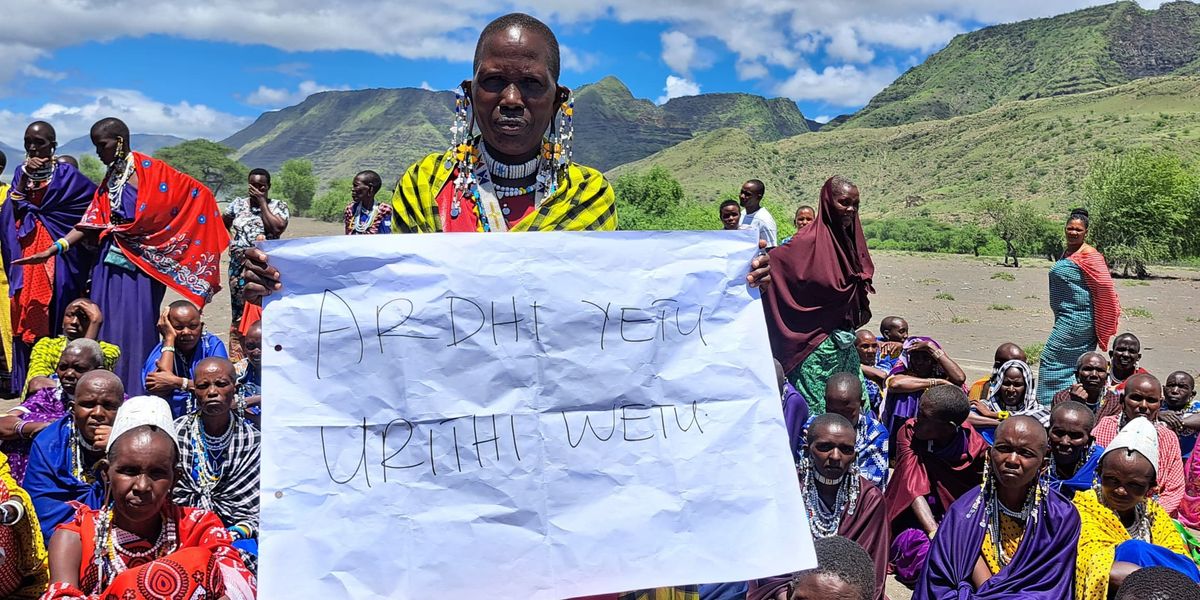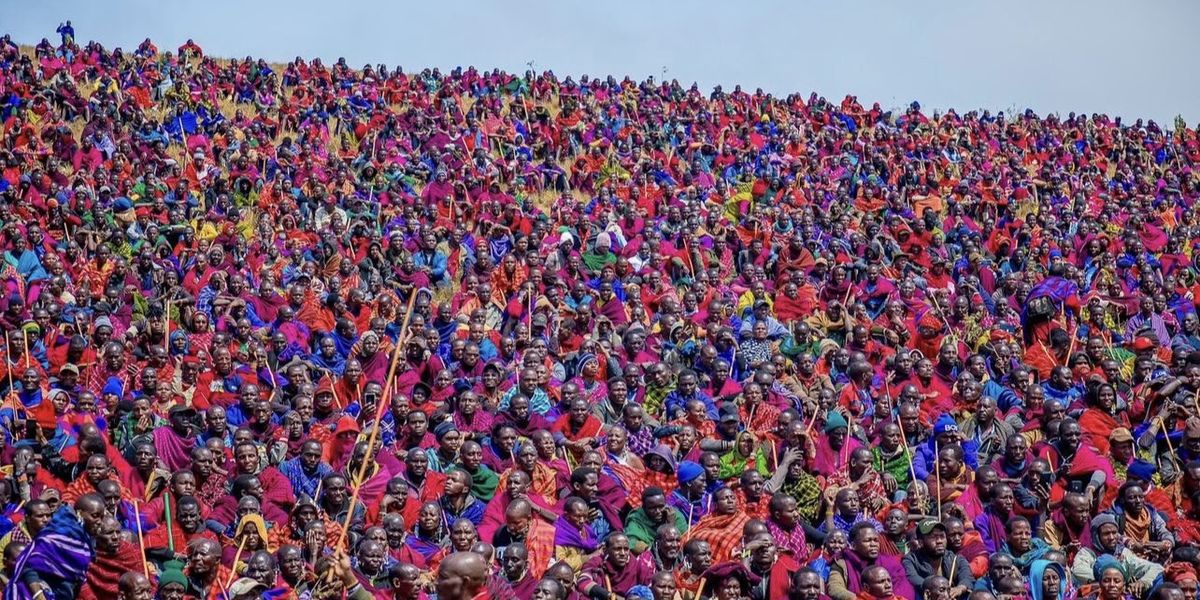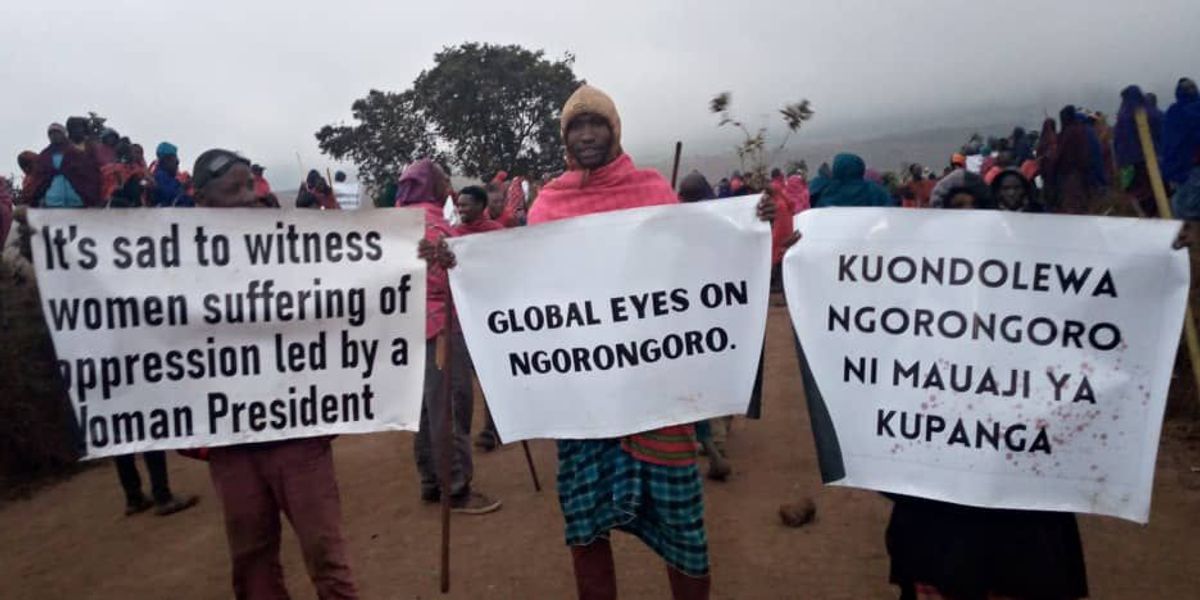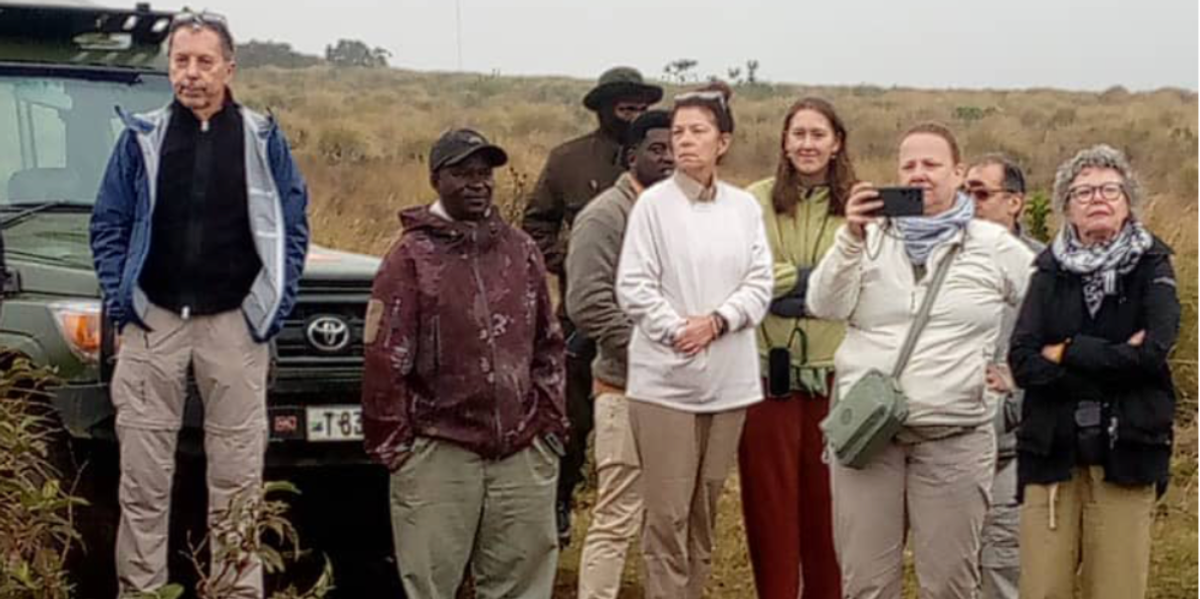

SUBSCRIBE TO OUR FREE NEWSLETTER
Daily news & progressive opinion—funded by the people, not the corporations—delivered straight to your inbox.
5
#000000
#FFFFFF
To donate by check, phone, or other method, see our More Ways to Give page.


Daily news & progressive opinion—funded by the people, not the corporations—delivered straight to your inbox.
If designating areas as World Heritage Sites endangers the survival of Indigenous peoples in African countries, UNESCO and IUCN’s outdated, colonial, and top-down approach to conservation must be dismantled immediately.
In the early morning of August 18, the safari cars that usually creep along the Ngorongoro-Serengeti highway, slowed by their sheer numbers, encountered a different challenge. Thousands of Maasai men and women, draped in red-patterned Shuka cloth and waving grass, a symbol of peace, were blocking the highway.
They were staging a peaceful protest against the Tanzanian government’s latest ruthless attempt to forcibly evict them from their ancestral lands. The police, wary of using violence in front of international tourists as they had in neighboring Loliondo in 2022, resorted to intimidation tactics instead, blocking vehicles carrying food and water from Karatu to the Ngorongoro Conservation Area (NCA) to weaken the resolve of the demonstrators.
“We are not blocking this highway out of choice. We are doing it for necessity. For too long our voices have been ignored, and out rights have been trampled. This is our last resort.”—Statement of the Maasai Community, NCA, August 18, 2024

A Maasai woman holds a sign reading, “This is our ancestral land.” (Photo: The Maasai elders, NCA)
Since Tanzania’s colonizers established the Serengeti National Park in 1951—displacing Indigenous residents to Loliondo and the Ngorongoro Conservation Area (NCA)—the pastoralist Maasai in Northern Tanzania have faced relentless struggles against evictions and human rights abuses. For the past four years, their resilience has endured brutal attacks designed to expel them from their ancestral lands, transforming the region into a people-free zone to enhance safari tourism and hunting, as glorified in Western media like Planet Earth. These atrocities are masked as environmental conservation and protection.
In April 2021, the Tanzanian government announced the Multiple Land Use Management Plan (MLUM), posing a grave threat to the Maasai’s survival in the NCA. This followed the March 2019 joint monitoring mission by the UNESCO World Heritage Centre (WHC), the International Union for Conservation of Nature (IUCN), and the International Council on Monuments and Sites (ICOMOS), which urged the government to control population growth in the NCA. The government responded by prioritizing tourism revenue, enacting the MLUM and a resettlement plan that expanded the NCA from 8,100 square kilometers to 12,083 square kilometers and created new restricted areas. In essence, this condemned nearly 80,000 Maasai to lives of destitution or death through forced evictions and the destruction of their livelihoods.
“The evictions and restrictions constraining tens of thousands of livelihoods are not about ensuring conservation but about expanding tourism revenues within the World Heritage Site. Tourism within the NCA has exploded in recent years with the number of annual tourists increasing from 20,000 in 1979 to 644,155 in 2018, making it one of the most intensively visited conservation areas in Africa. The number soared to 752,215 in 2023.”—The Oakland Institute

Maasai mobilize for their political rights. (Photo: The Maasai elders, NCA)
In response to international condemnation, the government falsely claimed that Maasai were volunteering en masse for resettlement at two relocation sites—Msomera village in Handeni district and Kitwai A and B villages in Simanjiro district. The flawed resettlement plans forced 11,000 Maasai community members from the NCA to send a letter to the government and its main donors stating their demand to remain in the NCA.
“This is not the first time that we are fighting to secure our rights and protect the lives of our people—we need a permanent solution and we need it now. We will not leave; Not Now, Not Ever!”—A Letter from Maasai Community to Tanzanian Government & International Donors, 2022
Despite the government’s claims that the Maasai’s relocation is voluntary, they have been forcibly uprooted by a systematic denial of essential social services, including education and healthcare. In May 2024, the government slashed nearly half of the budget for Endulen community hospital, the main healthcare provider for nearly 100,000 Maasai pastoralists in the NCA. These cuts ended vital support for facility repairs and community health initiatives. The grounding of the Flying Medical Service in 2022, after 39 years of critical emergency care, left over 24,000 children unvaccinated, deprived more than 5,700 pregnant women of necessary medical attention, and halted the delivery of life-saving HIV medications. While no official count of fatalities exists, it is undeniable that lives have been lost as a result.

Maasai hold protest signs on the Serengeti-Ngorongoro highway. (Photo: The Maasai elders, NCA)
In August, after failing to forcibly remove the Maasai from the NCA, the government struck a severe blow to their political rights. Ngorongoro Division was removed from the voters’ register, disenfranchising tens of thousands of Maasai pastoralists ahead of the upcoming local and general elections in 2025. Those registered to vote saw their polling station moved hundreds of miles away to Msomera village—the site of their forced relocation—effectively stripping even more Maasai villagers of their right to vote.
Adding to this assault on their political rights, Government Notice (GN) 673, issued on August 2, 2024, delisted 11 wards, 25 villages, and 96 subvillages in Ngorongoro Division, affecting over 110,000 people, all without obtaining their Free, Prior, and Informed Consent. This blatant violation of their rights sparked the August 18 protest, where Maasai residents demanded the reversal of GN 673 and the restoration of their electoral rights by the National Electoral Commission.
“We urge the Minister of Local Government to revoke and cancel Government Notice No. 673 of 2024, as it violates the constitution, laws, and international and regional treaties that Tanzania has signed and ratified.”—Onesmo Olengurumwa, National Coordinator, Tanzania Human Rights Defenders Coalition
As images of the Maasai, armed with grass and placards, demanding justice, went viral on August 22, 2024, the Arusha High Court temporarily suspended GN 673, pending further instructions. However, community lawyers have condemned the ruling as a sham. The court’s decision followed an injunction supposedly filed by Ngorongoro resident Isaya Ole Posi, who denies any involvement. Allegations have surfaced that the government paid the lawyer who filed the injunction against itself, in a calculated move to divert international attention sparked by the protests.

Stranded tourists stand watching the Maasai protests. (Photo: The Maasai elders, NCA)
While the Tanzanian government must undoubtedly be held accountable for violating the rights of its citizens, we must also scrutinize the role of two other key actors. The first are international conservation bodies like UNESCO, IUCN, and ICOMOS, under whose influence the government’s Multiple Land Use Model (MLUM) and resettlement plan were developed. It took an extensive global campaign to shift their stance. UNESCO’s website carries the government’s February 2024 report on the conservation status in the NCA, providing the false narrative that the relocation of local communities is voluntary, adheres to international best practices, and includes compensation measures. Yet, it also notes ongoing concerns from local communities, acknowledging the need for a human rights-based approach.
If designating areas like the NCA as World Heritage Sites endangers the survival of Indigenous peoples in African countries, UNESCO and IUCN’s outdated, colonial, and top-down approach to conservation—while boosting tourism—must be dismantled immediately. These institutions have reluctantly admitted that the NCA’s multiple land use model is appropriate, rather than altering its protected area category with disastrous consequences for residents. However, they have ignored calls for the NCA to be delisted from World Heritage sites and failed to pressure the government to stop its human rights violations.
As for the international tourists who continue to flock to Tanzania, lured by the chance to witness the “Big Five” or hunt trophies, the August 18 protests should serve as a wake-up call. The Maasai protesters and their global supporters have made their message clear: This is no longer a scene from “Out of Africa.” If there is no respect for Indigenous lives, then it must be “Tourism out of Tanzania!”
"Ensuring freshwater ecosystems are well managed, remain free-flowing with sufficient water, and good water quality is essential to stop species declines... in a climate-resilient world," one scientist said.
More than 20% of the world's freshwater fish species are in danger of extinction, according to the first-ever assessment of the category by the International Union for Conservation of Nature.
The assessment was released Monday as part of an update to the IUCN Red List of Threatened Species published to coincide with the United Nations Climate Change Conference (COP28). It found that 3,086 out of 14,898 listed freshwater fish species are at risk of disappearing, and at least 17% of threatened fish species are impacted by the climate crisis.
Barney Long, Re:wild's senior director of conservation strategies, said it was "shocking" that such a large percentage of "freshwater fish are now threatened with extinction and that climate change is now recognized as a significant contributing factor to their extinction risk."
"Climate change is menacing the diversity of life our planet harbors, and undermining nature's capacity to meet basic human needs."
The climate crisis can harm freshwater fish by altering seasonal rhythms, lowering freshwater levels, and increasing saltwater intrusion into freshwater ecosystems as sea levels rise. These changes only exacerbate the dangers freshwater fish already face: 57% of at-risk species are threatened by pollution, 45% by dams and water extraction, 33% by disease and invasive species, and 25% by fishing.
"Freshwater fishes make up more than half of the world's known fish species, an incomprehensible diversity given that freshwater ecosystems comprise only 1% of aquatic habitat," Kathy Hughes, co-chair of the IUCN Species Survey Commission Freshwater Fish Specialist Group, said in a statement. "These diverse species are integral to the ecosystem, and vital to its resilience. This is essential to the billions of people who rely upon freshwater ecosystems, and the millions of people who rely on their fisheries."
One example of a fish important to humans that is now at risk is Kenya's large-toothed Lake Turkana robber (Brycinus ferox). This species moved from "least concern" to "vulnerable" on the Red List because of dams, overfishing, and climate change-driven drought.
Another example is the Atlantic salmon, which has seen a "significant overall decline" in its population since around the turn of the 21st century, according to IUCN. This prompted the conservation body to revise its status from "least concern" to "near threatened." Atlantic salmon face a number of threats including dams, runoff pollution from logging and agriculture, diseases from farmed fish, overfishing, and the climate crisis.
"It appears that global climate change, resulting in rising sea, stream, and air temperatures, is a major driver acting on a wide range of factors influencing the Atlantic Salmon's life cycle," one study concluded.
It can do this by driving up stream and river temperatures so that they are too hot for fish to survive; increasing the range of invasive species; prompting fish to migrate early, which can decreases their chances of survival; and reducing prey availability, among other factors.
The overall Red List update also warned of the impacts of the climate crisis on species generally. For example, the Central South Pacific and East Pacific green turtles are now considered "endangered" and "vulnerable" respectively. The climate crisis adds to the stress on these animals by harming the seagrass they eat, threatening to flood nests with sea-level rise, and warming temperatures to an extent that decreases hatching success.
"Climate change is menacing the diversity of life our planet harbors, and undermining nature's capacity to meet basic human needs," IUCN director general Grethel Aguilar said in a statement. "This IUCN Red List update highlights the strong links between the climate and biodiversity crises, which must be tackled jointly. Species declines are an example of the havoc being wreaked by climate change, which we have the power to stop with urgent, ambitious action to keep warming below 1.5°C."
Conservationists emphasized the importance of protecting freshwater ecosystems in particular.
"Ensuring freshwater ecosystems are well managed, remain free-flowing with sufficient water, and good water quality is essential to stop species declines and maintain food security, livelihoods, and economies in a climate-resilient world," Hughes said.
Long agreed: "It is critical that we better safeguard our freshwater systems as they are not only home to precious and irreplaceable wildlife, but also provide humans with so many services that only the natural world can."
"Our work identifies hundreds of species—including 370 critically endangered and endangered species—in need of protections, and we also know data gaps mean the true figure could be much higher," said a study co-author.
New research identifying the hundreds of at-risk plant and animal species that lack international trade protections under a decades-old treaty led experts to call for key biodiversity-saving reforms on Tuesday.
The Convention on International Trade in Endangered Species of Wild Fauna and Flora (CITES) entered into force in 1975 and there are now 184 parties to the agreement, which currently protects nearly 41,000 species—including over 6,600 animals and 34,300 plants—from overexploitation.
"CITES listings should respond to the best available information on a species' status and be adopted where they will be likely to benefit the species," said University of Oxford research fellow Dan Challender, lead author of the analysis, in a Tuesday statement.
Challender worked with ecologists and wildlife trade experts at the International Union for Conservation of Nature (IUCN), the United Nations Environment Program World Conservation Monitoring Centre (UNEP-WCMC), and the Zoological Society of London for the study, published last week in the journal Nature Ecology & Evolution.
"CITES includes 59% (1,307 species), leaving two-fifths overlooked and in potential need of international trade regulation."
The paper explains that because "there is no established method to systemically determine which species are most at risk from international trade to information potential trade measures under CITES," the research team developed a mechanism using IUCN's Red List of Threatened Species, which includes assessments over 150,000 species.
"While our research shows CITES performs moderately well at identifying species in need of trade regulation, it also suggests that hundreds of species are overlooked," said Challender. "Cross-referencing data from the Red List with CITES listing information brings these potential protection gaps to light."
The team found that "of 38,245 globally threatened and near threatened species, 5.8% (2,211 species) are likely to be threatened by international trade." Of those at risk, "CITES includes 59% (1,307 species), leaving two-fifths overlooked and in potential need of international trade regulation." In other words, 904 species lack protections.
"Our work identifies hundreds of species—including 370 critically endangered and endangered species—in need of protections, and we also know data gaps mean the true figure could be much higher," noted study co-author Kelly Malsch of the UNEP-WCMC.
The endangered or critically endangered species that researchers said require safeguards from trade include 31 types of rays and sharks caught for fins and meat as well as 23 species of palm traded for horticulture.
Both Malsch and Challender expressed hope that the countries behind the treaty will use the new findings to inform future conference of the parties meetings. The next summit is scheduled for 2025.
"To achieve the aims of both CITES and the new Global Biodiversity Framework on tackling nature loss, it is vital that the international trade in animal and plant species is both sustainable and does not threaten the survival of the species in the wild," said Malsch, referencing an international plan agreed to in December. "We hope that CITES parties will be able to use our new methodology in future to ensure that CITES listings are based on the best available science."
The paper also points out that the number of species threatened by local and national resource depletion "is four times greater than species likely threatened by international trade," indicating the broader challenges faced by endangered plants and animals worldwide.
"To effectively address the overexploitation of species," the study stresses, "interventions focused on achieving sustainability in international trade need to be complemented by commensurate measures to ensure that local and national use and trade of wildlife is well-regulated and sustainable."
As Common Dreams reported in December, the Global Biodiversity Framework—whose overarching goal is protecting 30% of all land and water—did not alleviate fears about looming extinctions. While some U.N. and civil society leaders lauded the deal, others, particularly representatives of the Global South, sounded the alarm about corporate capture of protection efforts, promotion of agribusiness, and failures to adequately involve Indigenous peoples.